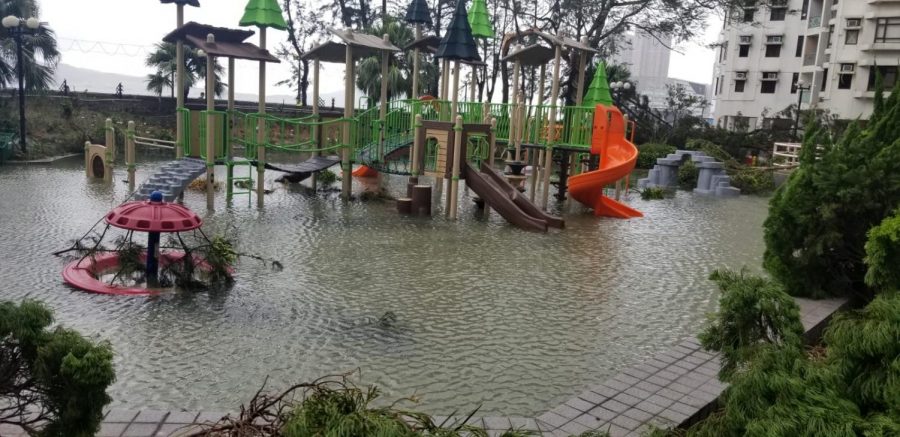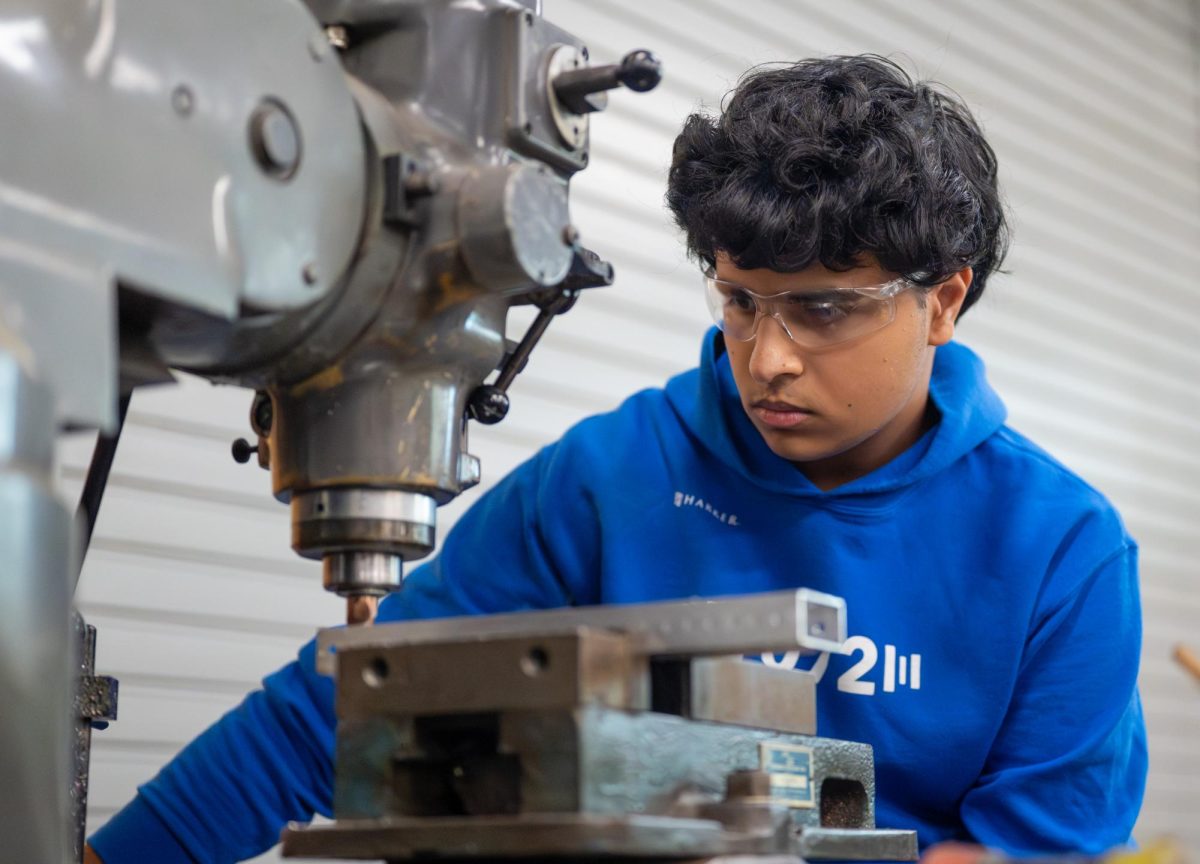Residents rebuild after super Typhoon Mangkhut damages Asia
October 17, 2018
Residents and governments are rebuilding cities after Typhoon Mangkhut, the strongest tropical storm of the year, swept through the Southeast Asia and Southern China, causing severe damage to infrastructure and agriculture.
Typhoon Mangkhut, or Typhoon Ompong, first landed in the Luzon province of the Philippines as a super typhoon on Sept. 15 with winds reaching 150 mph.
The Philippine Atmospheric, Geophysical and Astronomical Services Administration, who scales storms from 1 to 5, initially raised a Signal 3 alert but later changed it to a Signal 4. The typhoon then made its way to Southern China, categorized as a Signal 10 storm, from 1-to-10 scale, with 10 occurring rarely, by the Hong Kong Observatory on Sept. 16.
In the Philippines, the typhoon caused severe landslides, and at least 81 died from the storm. In Hong Kong, the storm destroyed high-rises, interrupted public transportation services, uprooted trees and damaged famous historical lights. Tens of thousands of people were stranded at the Hong Kong International Airport.
“There was a lot damage done, especially in the outlying areas of Hong Kong. A lot of buildings were damaged; trees were uprooted; even transport was affected. There were two days where school was suspended because of transport problems,” Hong Kong native Emily Hyland, 16, said. “There was debris on the roads, so they used two days to clean up everything for buses and cars to go through.”
Tropical cyclones have historically hit the northwestern Pacific more frequently than other areas. Southern China, Japan and the Philippines are hit by typhoons every year during the peak months of August to October.
“[Typhoons] happen about 25 to 35 times every year in the northwestern Pacific. In some cases, there are super typhoons that appear, and one example is Typhoon Mangkhut, which is a category 5 typhoon,” former AP Environmental Science student Emma Li (11) said. “[Categories] go from 1 to 5—1 being the least intense, 5 being the most intense. Its intensity is based on the speed in which the typhoon is spinning and displacing.”
The rising frequency and intensity of storms in the last few years have been related to climate change. Storms such as Typhoon Mangkhut are setting records for storms occurring within this century. Forecasters predict larger storms will happen more frequently.
“A lot of what drives the formation of these storms is the difference between the air and water temperature. With climate change the differentials are predicted to be greater. The warmer the air, the more moisture it can hold; the more moisture it can hold, the more powerful the storm,” biology teacher Dr. Katherine Schafer said.
Climate change not only contributes to storms with greater magnitude, but rising sea levels, causing more damage to coastal communities.
“For these low lying areas, regardless if the storms are more intense of not, sea level is rising. Even the storms of the same magnitude, the communities [of island nations] are more vulnerable, as they are closer to tide lines,” Schafer said. “that’s one of the things that’s such a tragedy. The most impacted people, at least early on, are the ones who contributed the least to the problem.”
Communities of volunteers in Hong Kong have come together for massive cleanups at beaches, oceans, streams, streets and villages.
“To help out with the local community, our school has volunteered to help clean up the roads around the school. [We] picked up branches, [which is] basically a small cleanup of the community,” Emily said.
As residents are recovering from the typhoon, nonprofits have also mobilized recovery effects that all people can join to help. Some organizations that accept donations are the American Red Cross, CARE, Catholic Relief Services, Episcopal Relief & Development, Global Giving, Philippine Red Cross Unicef.
This piece was originally published in the pages of The Winged Post on October 17, 2018.


















![“[Building nerf blasters] became this outlet of creativity for me that hasn't been matched by anything else. The process [of] making a build complete to your desire is such a painstakingly difficult process, but I've had to learn from [the skills needed from] soldering to proper painting. There's so many different options for everything, if you think about it, it exists. The best part is [that] if it doesn't exist, you can build it yourself," Ishaan Parate said.](https://harkeraquila.com/wp-content/uploads/2022/08/DSC_8149-900x604.jpg)




![“When I came into high school, I was ready to be a follower. But DECA was a game changer for me. It helped me overcome my fear of public speaking, and it's played such a major role in who I've become today. To be able to successfully lead a chapter of 150 students, an officer team and be one of the upperclassmen I once really admired is something I'm [really] proud of,” Anvitha Tummala ('21) said.](https://harkeraquila.com/wp-content/uploads/2021/07/Screen-Shot-2021-07-25-at-9.50.05-AM-900x594.png)







![“I think getting up in the morning and having a sense of purpose [is exciting]. I think without a certain amount of drive, life is kind of obsolete and mundane, and I think having that every single day is what makes each day unique and kind of makes life exciting,” Neymika Jain (12) said.](https://harkeraquila.com/wp-content/uploads/2017/06/Screen-Shot-2017-06-03-at-4.54.16-PM.png)








![“My slogan is ‘slow feet, don’t eat, and I’m hungry.’ You need to run fast to get where you are–you aren't going to get those championships if you aren't fast,” Angel Cervantes (12) said. “I want to do well in school on my tests and in track and win championships for my team. I live by that, [and] I can do that anywhere: in the classroom or on the field.”](https://harkeraquila.com/wp-content/uploads/2018/06/DSC5146-900x601.jpg)
![“[Volleyball has] taught me how to fall correctly, and another thing it taught is that you don’t have to be the best at something to be good at it. If you just hit the ball in a smart way, then it still scores points and you’re good at it. You could be a background player and still make a much bigger impact on the team than you would think,” Anya Gert (’20) said.](https://harkeraquila.com/wp-content/uploads/2020/06/AnnaGert_JinTuan_HoHPhotoEdited-600x900.jpeg)

![“I'm not nearly there yet, but [my confidence has] definitely been getting better since I was pretty shy and timid coming into Harker my freshman year. I know that there's a lot of people that are really confident in what they do, and I really admire them. Everyone's so driven and that has really pushed me to kind of try to find my own place in high school and be more confident,” Alyssa Huang (’20) said.](https://harkeraquila.com/wp-content/uploads/2020/06/AlyssaHuang_EmilyChen_HoHPhoto-900x749.jpeg)













